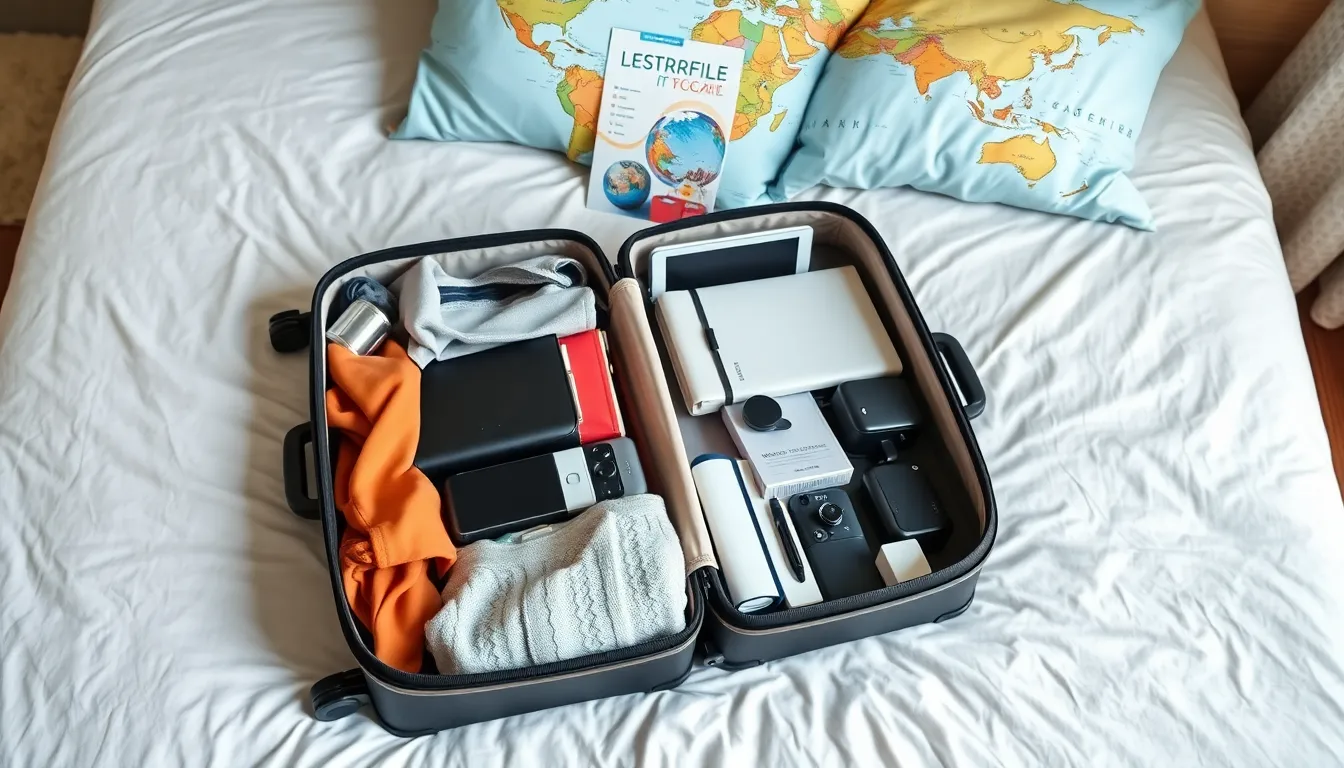Planning a trip can be both exciting and overwhelming. With so many details to juggle, it’s easy to feel lost in the chaos of bookings, itineraries, and packing lists. Effective travel organization is the key to transforming that stress into a smooth and enjoyable adventure.
By implementing a few simple strategies, travelers can streamline their planning process and focus on what truly matters—creating unforgettable memories. From utilizing digital tools to prioritizing essential tasks, these travel organization tips will help anyone navigate the complexities of trip preparation with ease. Get ready to embark on your next journey armed with the confidence that comes from being well-organized.
Table of Contents
ToggleEssential Travel Organization Tips
Organizing a trip efficiently enhances the travel experience. Here are critical tips for effective travel organization.
Create a Detailed Itinerary
Creating a detailed itinerary simplifies trip planning. Travelers should outline daily activities, including transportation, accommodations, and meals. Including specific addresses and contact numbers aids navigation. Digital tools like Google Maps or travel apps help access real-time information. Adapting the itinerary based on local events ensures relevance while keeping travelers informed about attractions or closures.
Set a Budget
Setting a budget establishes financial parameters for the trip. Travelers should itemize expenses such as accommodation, transportation, meals, and activities. Determining daily spending limits guides decisions and prevents overspending. Including a contingency fund for unexpected expenses allows flexibility. Using budgeting apps or spreadsheets facilitates tracking expenses and ensures financial ease throughout the journey.
Packing Strategies

Effective packing can enhance travel experiences by maximizing convenience and minimizing stress. Implementing smart strategies ensures essential items remain organized and accessible throughout the journey.
Choose the Right Luggage
Choosing suitable luggage impacts ease during travel. Select luggage that adheres to airline requirements for size and weight limits. Consider options such as:
- Carry-on bags: Opt for lightweight and durable materials that hold essentials while staying within airline size restrictions.
- Checked bags: Choose larger options for extended trips. Ensure durability to withstand rough handling during transit.
- Specialty bags: Use backpacks or wheeled suitcases designed for specific activities, such as hiking or business travel, which incorporate functional features.
Organize Your Packing List
Organizing a packing list streamlines the packing process. Create a detailed list categorized by function. Utilize the following categories for clarity:
- Clothing: List clothes based on daily requirements, considering the destination’s climate. Include versatile items to maximize outfit combinations.
- Toiletries: Include essentials like toothbrushes, deodorants, and medications, and opt for travel-sized containers to save space.
- Electronics: Itemize gadgets and their chargers. Prioritize devices needed for navigation, communication, or photography.
- Documents: Mention critical travel documents, including passports, itineraries, and insurance information, keeping them in an easily accessible location.
Implementing these strategies allows for organized and efficient packing, leading to a smoother and more enjoyable travel experience.
Time Management for Travelers
Effective time management enhances the travel experience by reducing stress and improving enjoyment. Implementing strategic planning ensures travelers maximize their trip.
Prioritize Your Activities
Travelers should identify must-see attractions and experiences. Creating a list of top priorities helps focus on essential activities and minimizes decision fatigue during the trip. For example:
- Rank attractions based on personal interests.
- Reserve tickets in advance for popular sites.
- Allocate specific time blocks for activities, including travel time.
- Factor in proximity when scheduling back-to-back visits.
This approach guarantees that travelers engage with experiences most meaningful to them while avoiding unnecessary time loss.
Schedule Downtime
Incorporating downtime into the itinerary proves beneficial for travelers. Breaks help recharge energy levels, allowing for more enjoyable experiences. For effective scheduling, consider:
- Designating at least one or two hours daily for relaxation.
- Choosing quieter locations for breaks, such as parks or cafes.
- Remaining flexible to adapt to unexpected needs for rest.
- Planning leisurely meals to unwind.
By balancing activity with downtime, travelers maintain productivity and enhance overall satisfaction during their journeys.
Utilizing Technology for Travel
Travelers increasingly rely on technology to streamline their planning and enhance their overall travel experiences. Utilizing various digital tools can significantly improve organization and ensure efficiency.
Apps for Organization
Travel organization apps simplify trip planning and management. Popular options include:
- TripIt: Automatically compiles travel details into a master itinerary, keeping all reservations in one place.
- Google Maps: Allows for navigation, direction planning, and saving favorite locations, making it easier to explore new areas.
- Kayak: Offers features like price alerts for flights and accommodations, helping travelers find the best deals.
- Packing Pro: Assists in creating customizable packing lists based on trip type, duration, and activities.
These tools help travelers stay organized, minimize hassle, and provide quick access to essential information.
Digital vs. Physical Documents
Digital documents offer convenience over traditional paper copies. Advantages of storing travel documents digitally include:
- Accessibility: Digital documents are accessible from any device with internet connectivity.
- Backup: Cloud storage provides a secure backup, reducing the risk of losing important information.
- Environmentally friendly: Digital storage eliminates the need for printing, reducing paper waste.
However, having physical copies remains beneficial. Key reasons include:
- Connectivity issues: In areas with limited internet access, physical documents ensure travelers have crucial information.
- Faster access: Physical copies can be quicker to retrieve during emergencies, unlike searching through a device.
Travelers often find a balance between digital storage and keeping essential physical documents, ensuring preparedness for any situation.
Effective travel organization transforms a potentially chaotic experience into an enjoyable adventure. By implementing the tips discussed travelers can streamline their planning process and focus on what truly matters: creating unforgettable memories.
Utilizing digital tools helps manage itineraries and budgets while effective packing strategies ensure convenience on the road. Prioritizing activities and allowing time for relaxation enhances enjoyment and reduces stress.
With these strategies in hand travelers can approach their next journey with confidence and excitement knowing they’re well-prepared for whatever comes their way. Embrace the adventure ahead and enjoy every moment.


